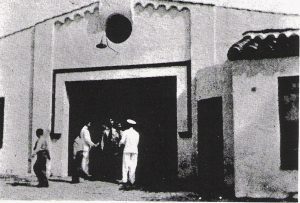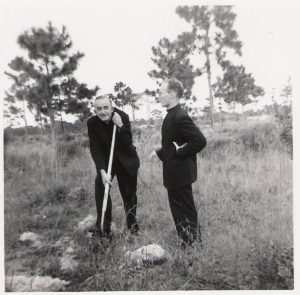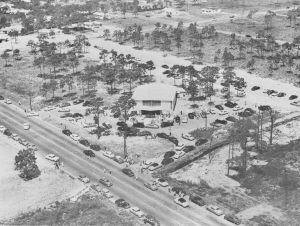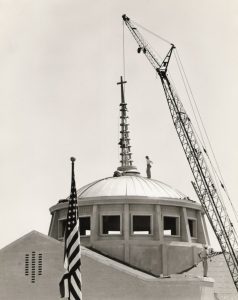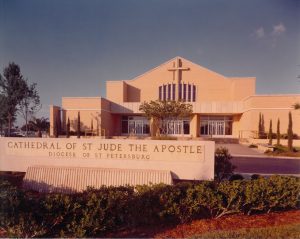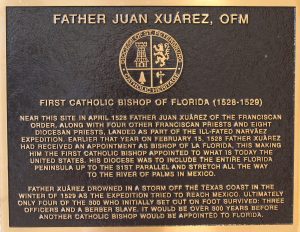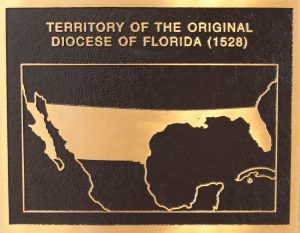History of the Cathedral of St. Jude the Apostle
In 1950, the Diocese of St. Augustine purchased ten acres of land between 5th and 7th Avenues North and 58th and 59th Streets in St. Petersburg, Florida. The land was swampy, snake-infested, and full of scrub pine.
On November 24, 1950, Father Paul Leo Manning was assigned to organize the sixth Roman Catholic parish in St. Petersburg. The name St. Jude the Apostle was suggested by one of the founding parishioners whose son had been severely injured in an automobile accident and was not expected to live. Through his father’s novenas to St. Jude Thaddeus, the boy recovered completely. The boy’s father spoke to Father Manning about honoring this little recognized Apostle-saint by naming the new parish after him. Father Manning agreed and presented the suggestion to Archbishop Joseph Hurley. On December 12, 1950, the archbishop announced the canonical erection of the Parish of St. Jude the Apostle.
The parish boundaries were to include the north side of St. Petersburg west of 34th Street and a large portion of the south side of the city, these areas were previously parts of St. Paul, St. Joseph, and St. John Vianney parishes.
The Parish of St. Jude the Apostle celebrated its first Mass on Sunday, February 11, 1951 on the grounds of Admiral Farragut Academy. Seventy-five parishioners knelt on the bare concrete floor of a garage to signal the beginning of a long, distinguished, and holy history.
On Sunday, April 4, 1951, ground was broken for a church-auditorium. Father Manning, assisted by Monsignor John J. Mullins, Pastor of St. Paul’s Church, St. Petersburg, and Monsignor Patrick Donahue, Pastor of St. Mary Our Lady of Grace, St. Petersburg, turned the first shovel. The building was constructed in a contemporary design from concrete blocks.
The first Mass in the newly constructed building took place on October 7, 1951. At last, parishioners were in a church of their own. Their collective feeling of pride and joy was an appropriate tribute to their hard work. On January 17, 1952, Archbishop Hurley blessed the building. In October 1952, the first anniversary solemn High Mass and novena was offered in Thanksgiving.
To accommodate the rapid growth of the parish, the Diocese of St. Augustine acquired five additional acres of land between 7th and 8th Avenues North for $30,000. The church building on the original property could accommodate about three hundred people, but it was not long before the four Sunday Masses became over-crowded. In a few years, construction of a new church would begin on the additional land.
On March 31, 1953, Father Manning was transferred, and Monsignor James J. Meehan became St. Jude’s new pastor on April 15, 1953. For 32 years he had served as the pastor at Immaculate Conception Parish in Jacksonville. Now, he had the task of St. Jude’s growth, which had exceeded all expectations.
Soon after Monsignor James J. Meehan arrived, a small but adequate masonry house, adjacent to the auditorium at 5th Avenue North, became the new rectory. A drainage canal separated the rectory from the church-auditorium. The canal became known as St. Jude’s Canal and the priests had to cross a wooden bridge to get to the church. In 1959, the canal was enclosed and became 58th Street North.
Ground was broken for a school building and convent on the Feast of St. Augustine, August 28, 1953. A two-story building was completed in April 1954. The first floor was used as a church and the second floor housed eight classrooms. Even before the church was completed, the first Mass was held on Sunday, January 24, 1954. Archbishop Hurley, in a moment of literary inspiration, penned a letter to St. Jude parishioners, which read in part:
There in the intersection of two of St. Petersburg’s greater traffic arteries, a greater St. Jude’s will stand as the lighthouse of the Faith, showing forth to the thousands who pass by, the truth, the love, and the goodness of God.
Although the school-church building accommodated about 1,000 people for Mass, it was not long before the rapid growth of northwest St. Petersburg found the building inadequate to accommodate the increasing number of parishioners. On the Feast of the Nativity of the Blessed Virgin Mary on September 8, 1961, all the school children and parish organizations gathered at the groundbreaking for a new and permanent church. The design of the church was derived from the Byzantine period of the Eastern Roman Empire and the plan was based on a Latin Cross. The principal sections focused on a circular sanctuary on an elevated surface, seven steps above the main floor. The dome, rising 62 feet above the sanctuary, featured beautiful stained-glass windows designed to cast light on the altar below. The exterior of the dome was to be covered with gold colored aluminum.
Construction progressed at a steady pace and on April 26, 1962, Monsignor Meehan invited all the school children to watch as the 25-foot finial and cross were hoisted into place on top of the golden dome. The cross, also golden in hue, would reflect the rays of the sun and light the way to the kingdom of God.
St. Jude’s The Church of St. Jude the Apostle was solemnly dedicated on Pentecost Sunday on June 2, 1963. The Most Reverend Henry Murphy, Bishop of Limerick Ireland, and a long-time friend of Monsignor Meehan, officiated at the dedication ceremonies and celebrated the Solemn Pontifical Mass of Thanksgiving that followed. Archbishop Hurley presided at the ceremony.
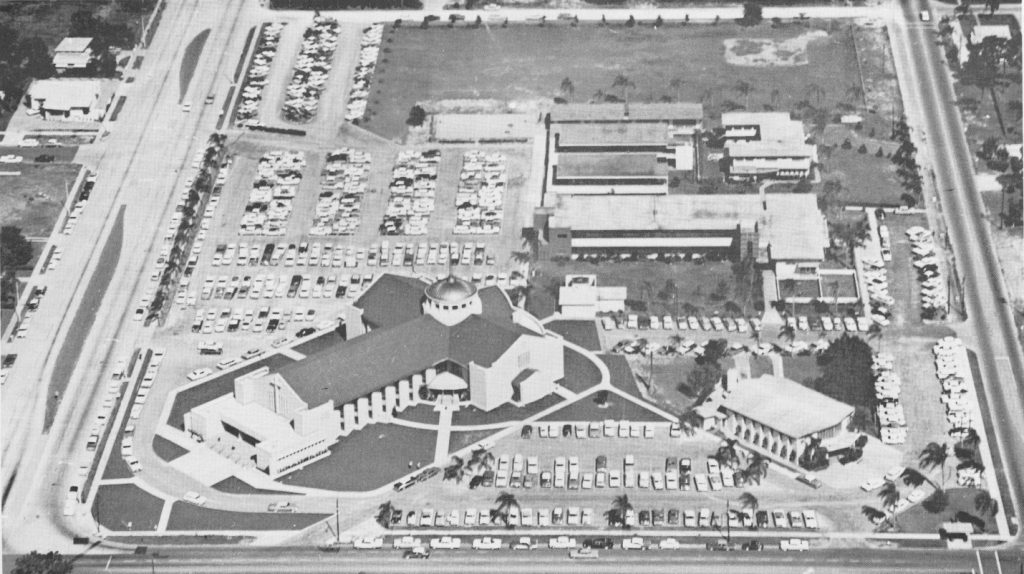
The growth of Florida’s population led to the establishment of the Diocese of St. Petersburg on June 17, 1968. The Parish of St. Jude was elevated to cathedral status for the newly formed diocese by Pope Paul VI. St. Jude Parish officially became the Cathedral of St. Jude the Apostle with the appointment and installation of Bishop Charles B. McLaughlin of North Carolina as the first Bishop of St. Petersburg on May 8, 1968. Apostolic Delegate, the Most Reverend Luigi Raimondi, officiated at the ceremonies and celebrated Mass.
After 16 years of service as pastor, Monsignor Meehan retired on June 4, 1969. Until his death on November 8, 1972, he continued to serve whenever needed and was a vital influence on everyone who knew him.
Monsignor John Scully, former pastor of St. Patrick Parish in Tampa, was named new pastor of St. Jude in June 1969 and served for three years. Through the diocesan office of Propagation of the Faith, he left for Africa to serve as a missionary in June 1972.
The Cathedral’s next pastor was Father James Gloekler, who came to St. Jude in September 1972 from St. Mary Our Lady of Grace in downtown St. Petersburg. Father Gloekler was instrumental in helping the parish enjoy a prominent status as the Cathedral of the Diocese of St. Petersburg.
Most Reverend Charles B. McLaughlin, the first bishop of the Diocese of St. Petersburg, died on December 14, 1978. He was in office at the time of his death, and the entire Diocese of St. Petersburg mourned the loss of their active, loved, and well-respected bishop. Most Reverend W. Thomas Larkin was installed as the second bishop of the Diocese of St. Petersburg on April 24, 1979.
August 1980 saw the installation of a new carillon system. The highly anticipated and celebrated system provided a specific programming versatility for the parish and the true sound of traditional English bells without taking up the space necessary for a true carillon bell tower. Parishioners soon recognized the tolling for the Angelus, liturgical calls, and various hymns.
By 1981, St. Jude had grown larger as more families registered. It became obvious that the small social hall was not sufficient for the many functions of a large parish. A new parish center was built and dedicated on October 28, 1982. In 1983 a parish administration addition was built adjacent to the center.
The following year, the original church-auditorium (built in 1951) was renovated and renamed “Our Lady’s Chapel.” The renovation provided a lovely setting and served as a devotional chapel for daily Mass, funerals, and small weddings. The first Mass in Our Lady’s Chapel was offered on December 10, 1984. Bishop W. Thomas Larkin dedicated the Chapel on February 15, 1985.
In January 1986, St. Jude Parish acquired a banner bearing the Coat of Arms for the Cathedral. The banner was introduced to parishioners in a procession prior to Mass and displayed in the Cathedral. The design consists of a red cross and amber disc on a green banner. The red cross represents the martyrdom of St. Jude, while the amber disc represents the medallion held by St. Jude. The cross and disc also represent the shape of the cathedral with its red tile roof and golden dome. Placed in the center of the disc were the symbols of St. Peter, the inverted cross of his martyrdom and the crossed keys entrusted to him by Christ. The banner and coat of arms quickly became a symbol of the vital faith and generous dedication of the people of the Cathedral of St. Jude the Apostle.
On Sunday, May 22, 1988, Father Caverly invited all parishioners to celebrate the 25th Anniversary of the parish church and honor the 20th Anniversary of its elevation to cathedral status. Bishop W. Thomas Larkin was the principal celebrant at the anniversary Mass and parishioners gathered in the parish center to share their good fortune.
Bishop Larkin retired in November 1988. On March 7, 1989, Most Reverend John C. Favalora was appointed the third bishop of St. Petersburg. The Cathedral of St. Jude the Apostle hosted his installation on May 16. Many parishioners attended the installation.
St. Jude Parish had enjoyed the beautiful sounds of their adult choir; a Children’s Choir was established in May 1992 and made its debut at two Saturday Masses. The choir began with 25 children from St. Jude School and the religious education program. Both the adult and children music programs were soon known for their high standard of excellence.
Bishop Favalora was transferred to the Diocese of Miami and elevated to Archbishop in 1995. On January 26, 1996, the Cathedral of St. Jude hosted the Episcopal ordination and installation of the fourth bishop of St. Petersburg, the Most Reverend Robert N. Lynch. The wonderful moment was televised throughout the state of Florida and displayed the beauty and grace of the Cathedral.
After 20 years as St. Jude’s pastor, Msgr. Caverly was reassigned in June 1996. In that same month, Reverend David DeJulio was appointed rector of the cathedral.
Soon after his appointment, Fr. DeJulio inaugurated a highly successful, year-long capital campaign fund drive to acquire a new organ and a new rectory. The St. Jude Director of Music Ministries oversaw the installation of the pipes in May 1997. The number of cathedral choirs increased to six and a series of Sunday afternoon concerts was instituted. In the summer of 1997, the second goal of the capital campaign was fulfilled. The new rectory offered modern facilities and privacy for St. Jude clergy. In June 1999, preparation began for St. Jude’s 50th Anniversary, which coincided with the beginning of the Third Christian Millennium – the year 2000. A theme was established for each month of the Jubilee year and many events were planned including a diocesan life pilgrimage to the Nombre De Dios Mission in St. Augustine, a parish picnic, parish mission retreat, and Jubilee year Golden Gala.
After 24 years, most of it as principal, Sister Patricia Caulfield, O.P., retired from the Cathedral School of St. Jude in 2000. The much-loved Sr. Pat died in 2010 during her 57th year of Religious Profession.
In July 2004, Fr. Gregg Tottle was appointed Rector of the Cathedral. The first Christ Renews His Parish weekends at the Cathedral were held in October 2004. In 2005, ground was broken for one of the parish’s newest projects: a school complex for Academic, Religious, and Social Education classes. The new school building was dedicated in January 2007
The Cathedral Renovation project began in the fall of 2008 under the direction of Bishop Robert Lynch. Under the bishop’s guidance, a Steering Committee – comprised of diocesan members, clergy, and staff, began meeting with a liturgical consultant, architect, acoustical consultant and contractor to develop a vision and plan to renovate the Cathedral. From the moment of its inception, the Steering Committee was focused on maintaining the integrity and beauty of the Cathedral, listening to all viewpoints, and keeping the project a spiritual and holy endeavor.
Fr. Joseph Waters was appointed rector of the Cathedral in July 2009. Serving with St. Jude parishioner Maureen Ahern as co-chair of the Cathedral Renovation Steering Committee, Fr. Waters oversaw the different stages of the renewal project. It was on Pentecost Sunday, June 2, 1963, that St. Jude’s Church was solemnly dedicated. And, it was on Pentecost Sunday, May 27, 2012, that the last Mass in the original Cathedral was celebrated. Construction for the renovation began on June 4, 2012. In September 2013, after a little over a year of construction and renovation, the renovated Cathedral of St. Jude the Apostle was dedicated.
On November 28, 2016, Pope Francis named Bishop Gregory L. Parkes of the Diocese of Pensacola-Tallahassee as the fifth Bishop of the Diocese of St. Petersburg. Bishop Parkes became the first bishop to be installed in the newly renovated Cathedral on January 4, 2017.
The Cathedral served as the home of two large diocesan celebrations commemorating the Diocese of St. Petersburg’s 50th Anniversary in the spring of 2018. In a solemn vespers service on Sunday, May 6, Bishop Parkes consecrated the diocese to the Immaculate Heart of Mary. The Diocesan 50th Anniversary Mass was held on Saturday, June 16.
Bishop Parkes appointed Fr. Arthur Proulx as the ninth rector of the Cathedral effective July 2018.
Bishop Parkes appointed Fr. Tom Morgan as the tenth rector of the Cathedral effective July 2023.

